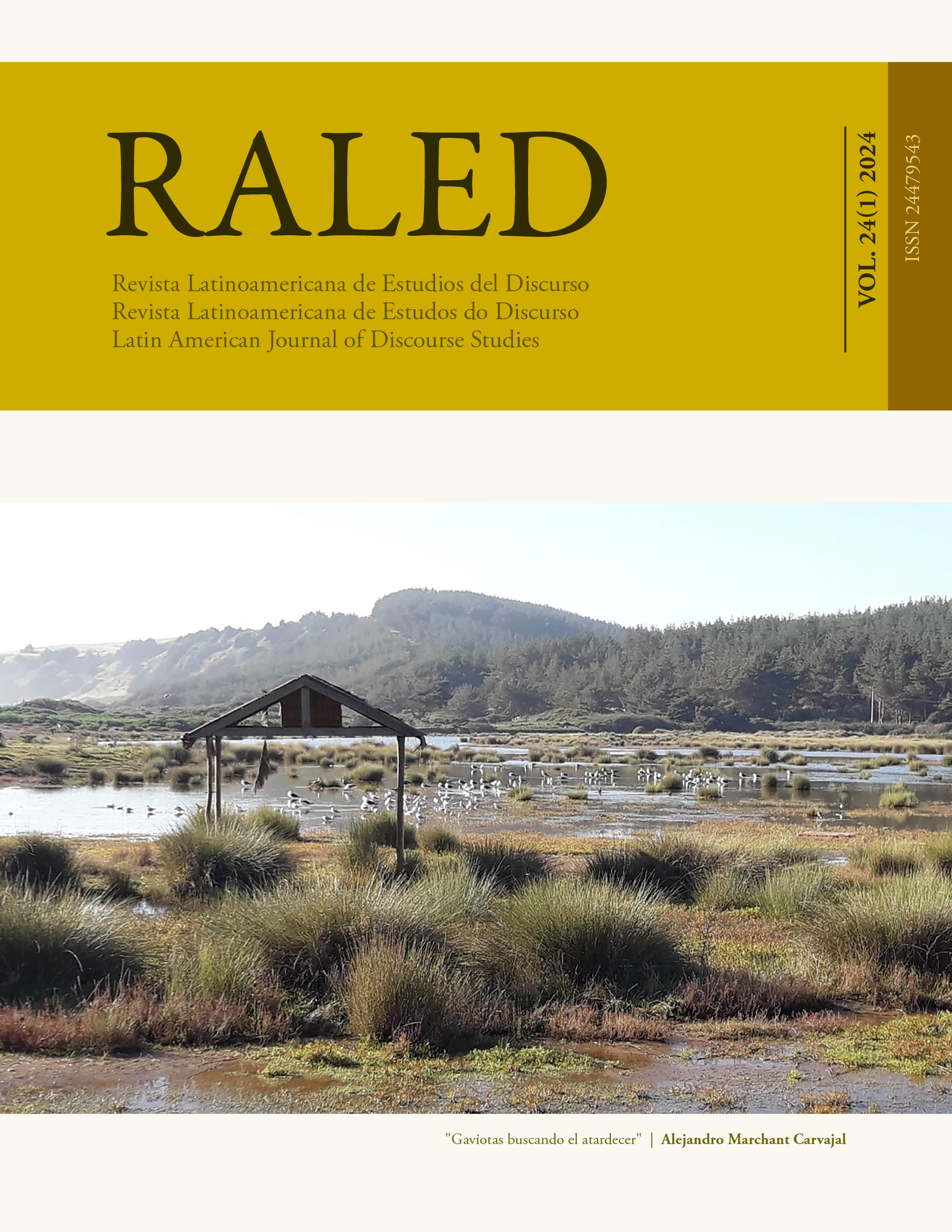“Each ‘like’ is one migrant less in our country”: A study of xenophobic discourse in Mexico as shown in a corpus of YouTube comments
DOI:
https://doi.org/10.35956/v.24.n1.2024.p.86-105Keywords:
Migrants, Central America, Mexico, Xenophobia, Lexical Priming, YouTubeAbstract
This is a descriptive study about xenophobic discourses against Central American migration. Considering Lexical Priming Theory (Hoey 2005), we attempt to unravel the ideological uses of the linguistic pattern <possessive + place (casa, país, nación)>. The materials analyzed are comments made in videos published in YouTube dealing with the migrant caravans heading towards the Mexican border with the USA. Our results show specific and metaphorical uses that mostly support Mexican nationalists’ discourses against Central American Migrants. Semantic clustering of the verbs nested in that pattern points towards fears (phobias and prejudices) that the users of those platforms show against migrants.
Downloads
References
Anthony, L. 2022. AntConc (v.4.0.3) [Computer Software]. Waseda University, Tokyo
Real Academia Española. 2023. Lugar | Diccionario de la lengua española. - Edición del Tricentenario. Recuperado 22 de mayo de 2023, de https://dle.rae.es/lugar
Real Academia Española. 2023. Migrar | Diccionario de la lengua española. - Edición del Tricentenario. Recuperado 17 de abril de 2023, de https://dle.rae.es/migrar
Baker, H., McEnery, T., y Hardie, A. 2017. A corpus-based investigation into English representations of Turks and Ottomans in the early modern period. En M. Pace-Sigge y K. J. Patterson (eds). Lexical Priming: Applications and Advances, pp. 41-66. Ámsterdam/ Filadelfia: John Benjamins Publishing Company
Baker, P., y McEnery, T. 2005. A corpus-based approach to discourses of refugees and asylum seekers in UN and newspaper texts. Journal of Language and Politics, 4, 2: 197-226.
Bevitor, C. 2018. Crossing Boundaries: Investigating «Fair» in British Parliamentary Debates on Im/migration. Textus 1: 165-186.
Church, K, y Hanks, P. 1990. Word Association Norms, Mutual Information, and Lexicography. Computational Linguistics 161: 22-29.
Dobrić Basaneže, K. y Ostojić, P. 2021. Migration Discourse in Croatian News Media. Medijska Istraživanja 27, 1: 5-27.
Douglas. S. M, 2008. La racialización de los mexicanos en Estados Unidos: estratificación racial en la teoría y en la práctica. Migración y Desarrollo 10: 65-95.
Fairclough, N. 2013. Critical Discourse Analysis: The Critical Study of Language. 2.a ed. London: Routledge.
Fotopoulos, S. y Kaimaklioti, M. 2016. Media Discourse on the Refugee Crisis: On what have the Greek, German and British Press Focused? European View 15, 2: 265-279.
Fowler, R. 1991. Language in the News: Discourse and Ideology in the Press. Nueva York: Routledge.
Gabrielatos, C. y Baker, P. 2008. Fleeing, Sneaking, Flooding: A Corpus Analysis of Discursive Constructions of Refugees and Asylum Seekers in the UK Press, 1996-2005. Journal of English Linguistics 36, 1: 5-38.
Hardt-Mautner, G. 1995. ‘Only Connect.’ Critical Discourse Analysis and Corpus Linguistics. Harris, L. H. y Fiske, S. 2006. Dehumanizing the Lowest of the Low: Neuroimaging Responses
to Extreme Out-Groups. Psychological Science 17, 10: 847-53.
Hoey, M. 2005. Lexical priming: A new theory of words and language. Abingdon: Routledge
Hoey, M. 2017. Cohesion and coherence in a content-specific corpus. En M. Pace-Sigge, M. y Patterson, K. J. (eds). Lexical Priming: Applications and Advances, pp. 41-66. Ámsterdam/ Filadelfia: John Benjamins Publishing Company
Montali, L., Riva, P., Frigerio, A. y Mele, S. 2013. The representation of migrants in the Italian press: A study on the Corriere della Sera (1992–2009). Journal of Language and Politics 12, 2: 226-250
Porto Dapena, J. Á. 1982. Los posesivos personales del español: Intento de descripción funcional. Dicenda. Estudios de lengua y literatura españolas 1: 55-108.
Reyes Vázquez, J. F. y Barrios de la O, M. I. 2019. El comportamiento de los usuarios de Twitter respecto al tema de la Caravana Migrante a través del Sentiment Analysis, De política 13, 7: 11
Simpson, P. 1993. Language, Ideology and Point of View. London: Routledge
Stubbs, M. 1995. Collocations and cultural connotations of common words. Linguistics and Education 7, 4: 379-390
Stubbs, M. 1996. Text and Corpus Analysis. Oxford: Blackwell.
Stubbs, M. 1997. Whorf ’s children: Critical comments on critical discourse analysis (CDA). British studies in applied linguistics 12: 100-116.
Stubbs, M. 2001. Computer-assisted Text and Corpus Analysis: Lexical Cohesion and Communicative Competence. En Schiffrin, D., Tannen, D., y Hamilton, H. E. The Handbook of Discourse Analysis. John Wiley & Sons.
Taylor, C. 2009. The representation of the inmigrants in the italian Press. Università Degli Studi Di Siena Dipartimento Di Scienze Storiche, Giuridiche, Politiche E Sociali.
Taylor, C. 2014. Investigating the representation of migrants in the UK and Italian press: A cross-linguistic corpus-assisted discourse analysis. International Journal of Corpus Linguistics 19, 3, 368-400.
Taylor, C. y Marchi, A. 2018. Corpus Approaches to Discourse: A Critical Review. Abingdon New York: Routledge.
Van Dijk, T. (ed.). 2016. Racismo y discurso en América Latina. Barcelona: Gedisa.
Wang, L., Ma, Q., Song, Z., Shi, Y., Wang, Y. y Pfotenhauer, L. 2011. N400 and the activation of prejudice against rural migrant workers in China. Brain research 1375:103-10.
White, K., Crites J. R. S., Taylor, J. y Corral, G. 2009. Wait, what? Assessing stereotype incongruities using the N400 ERP component. Social Cognitive and Affective Neuroscience 4(2):191-98.
Downloads
Published
How to Cite
Issue
Section
License
Copyright (c) 2024 Ana Ruth Sánchez Barrera, Ignacio Rodríguez Sánchez

This work is licensed under a Creative Commons Attribution-NonCommercial-NoDerivatives 4.0 International License.
The authors retain the copyright and guarantee RALED the right to be the first publication of the work as well as a Creative Commons Attribution License that allows others to share the work with recognition of authorship and the initial publication in this journal.




